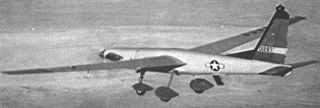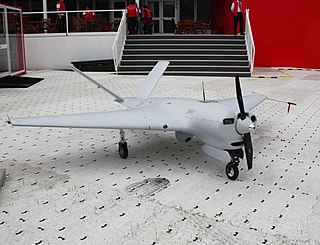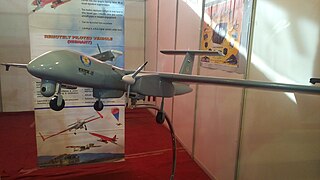Related Research Articles

The AAI RQ-2 Pioneer is an unmanned aerial vehicle (UAV) that had been used by the United States Navy, Marine Corps, and Army, and deployed at sea and on land from 1986 until 2007. Initially tested aboard USS Iowa, the RQ-2 Pioneer was placed aboard Iowa-class battleships to provide gunnery spotting, its mission evolving into reconnaissance and surveillance, primarily for amphibious forces.

The AAI RQ-7 Shadow is an American unmanned aerial vehicle (UAV) used by the United States Army, Australian Army, Swedish Army, Turkish Air Force and Italian Army for reconnaissance, surveillance, target acquisition and battle damage assessment. Launched from a trailer-mounted pneumatic catapult, it is recovered with the aid of arresting gear similar to jets on an aircraft carrier. Its gimbal-mounted, digitally stabilized, liquid nitrogen-cooled electro-optical/infrared (EO/IR) camera relays video in real time via a C-band line-of-sight data link to the ground control station (GCS).
The Alliant RQ-6 Outrider unmanned aerial vehicle (UAV) was designed to provide near-real-time reconnaissance, surveillance, and target acquisition information to United States Marine Corps air/ground task forces, United States Army brigades, and deployed United States Navy units that was small enough for an entire system to be contained on two Humvees and trailer and transported on a single C-130 Hercules cargo aircraft.

The Sikorsky Cypher and Cypher II are types of unmanned aerial vehicles developed by Sikorsky Aircraft. They are vertical takeoff and landing aircraft which use two opposing rotors enclosed in a circular shroud for propulsion.
The BAI Aerosystems (BAIA) BQM-147 Dragon unmanned aerial vehicle is a tactical battlefield UAV operated by the US Marine Corps.

The BAE Systems Phoenix was an all-weather, day or night, real-time surveillance Unmanned Air Vehicle. It had a twin-boom UAV with a surveillance pod, from which the imagery was data linked to a ground control station (GCS) that also controlled the aircraft in flight. It was the third generation of UAV in British Army service with the Royal Artillery after SD/1 and Canadair Midge.

The MMIST CQ-10A SnowGoose is a cargo delivery unmanned aerial vehicle that has reached IOC with the United States Armed Forces with the delivery of 15 vehicles. The SnowGoose UAV is produced by the Canadian company Mist Mobility Integrated Systems Technology (MMIST). The SnowGoose UAV is an application of MMIST's Sherpa autonomous GPS-guided parafoil delivery system and is intended for pin-point delivery of small cargo items to special forces. A fully loaded Snowgoose can carry a total of 272 kg (600 lb). The SnowGoose was originally designed for leaflet dispensing, but can support a variety of missions with its six modular cargo bays, each of which can carry pods for fuel, cargo, or electronics packages.

The Ling-Temco-Vought XQM-93 was a remotely piloted aircraft developed in the United States in the late 1960s and early 1970s for use as a communications relay in the Vietnam War. A prototype flew in 1970, but the program was abandoned without producing a service-ready aircraft.

The DRS Sentry HP is a reconnaissance UAV that was developed in the United States in the late 1980s by S-TEC. The program was acquired by Meggitt in 2000 and subsequently by DRS in 2002. Although the aircraft shares the name "Sentry" with a previous S-TEC design, the Sentry HP is a completely different machine, with a broad wing and a V tail. The Sentry HP is larger, with greater payload capacity and an underwing stores capability. It is powered by a variant of the same engine as the Sentry. It can be ordered with an option for fixed landing gear to permit conventional takeoff and recovery.

The IAI Scout is a reconnaissance unmanned air vehicle developed in Israel in the 1970s by Israel Aircraft Industries as a competitor to the Tadiran Mastiff. The project was led by Charley Attali, David Harari, and Michael Shefer who were all awarded the 1981 Israel Defense Prize. During the 1970s, the Israeli military was becoming increasingly interested in battlefield UAVs, and in response IAI management finally decided that they were interested in the concept as well. The Scout had a similar configuration as the Mastiff, with a pusher propeller and a twin-boom tail.
The Silver Arrow Mini-V is a small reconnaissance UAV developed in Israel in the 1990s.

The Sagem Crecerelle ("Kestrel") is a reconnaissance UAV developed in France in the 1990s, based on the Meggitt Banshee target drone. Its configuration is much like that of the Banshee, with a pusher prop, a clipped delta wing, and a single tailfin, though its fuselage is more cylindrical. It is powered by a 20 kW (26 hp) rotary engine and has no landing gear, being recovered by parachute and airbags. The Crecerelle saw action with French forces during the Kosovo campaign in 1999. Meggitt sells much the same machine as the Spectre.
Kapothaka was a technology demonstrator mini-UAV for reconnaissance. The Kapothaka which means “dove” is believed to be a predecessor of Nishant UAV system.
TAI Pelikan, aka IHA-X2, is a radio-controlled reconnaissance, surveillance and target acquisition drone. Designed, developed and built by Turkish Aerospace Industries (TAI), the unmanned aerial vehicle (UAV) is a half scale model of the tactical drone TAI Baykuş air platform. It was produced as a training and bridge platform to the TAI Baykuş.

TAI Gözcü is a radio-controlled short-range tactical drone. Designed, developed and built by Turkish Aerospace Industries (TAI), the unmanned aerial vehicle (UAV) is in use by the Turkish Armed Forces for intelligence, surveillance, target acquisition and reconnaissance purposes. Gözcü is the Turkish word for observer.
The Aerojet SD-2 Overseer was an unmanned aerial vehicle developed by Aerojet General and Rheem Manufacturing Co. in the late 1950s for use by the United States Army. Built in limited numbers, it never saw operational service.

Tactical Airborne Platform for Aerial Surveillance-Beyond Horizon-201 or TAPAS BH-201 is a long endurance unmanned aerial vehicle (UAV) which used to be previously referred as Rustom-II, being developed by India on the lines of the American Predator drones. First flight of the UAV took place in November 2016 after a 3-year delay. It was revealed at that time that the UAV has been renamed from Rustom-II to TAPAS-BH-201, an acronym for Tactical Airborne Platform for Aerial Surveillance-Beyond Horizon-201. The basic TAPAS BH-201 is classified as a medium-altitude long-endurance unmanned aerial vehicle

The Cloud Shadow, is an unmanned aerial vehicle of the High-Altitude Long Endurance (HALE) type, featuring an stealthy air-frame. As of 2017 it is being developed by the Chengdu Aircraft Industry Group for reconnaissance and precision strike missions.

The TAI Aksungur is an unmanned aerial vehicle (UAV) built by Turkish Aerospace Industries (TAI) for the Turkish Armed Forces. Using existing technology from the TAI Anka series of drones, it is the manufacturer's largest drone with payload capacity for mission-specific equipment. It is intended to be used for long-term surveillance, signals intelligence, maritime patrol missions, or as an unmanned combat aerial vehicle. TAI planned to integrate weapon packages and put the Aksungur into production in early 2020.
The Luch Korsar is a medium-weight Russian unmanned aerial vehicle developed by OKB Luch, member of Roselectronika, to perform reconnaissance, strike and electronic attack missions on behalf of the Russian Ground Forces and Navy. The program started in 2009 and at least 3 prototypes have been built as of 2019. It is considered as an improved analogue of the US-made RQ-7 Shadow UAV.
References
This article contains material that originally came from the web article Unmanned Aerial Vehicles by Greg Goebel, which exists in the Public Domain.